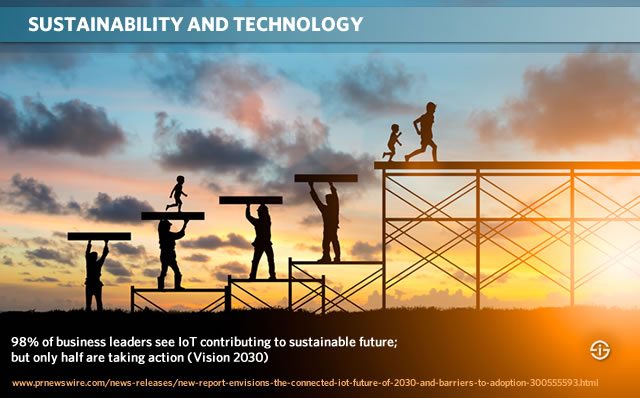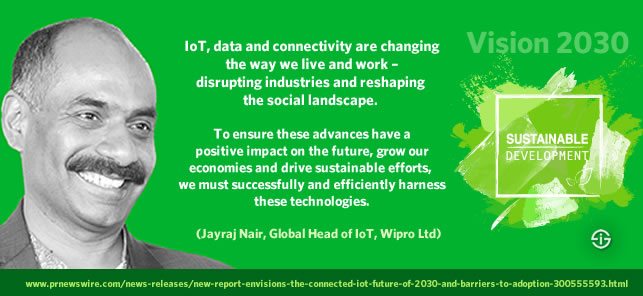Can technologies – and the will to leverage them – lead to a more sustainable future and, if so, how? It’s one of the questions addressed in a report by Wipro Digital and and Forum for the Future.
A broader look at sustainability and technology, spiced with some takeaways from the report, entitled ‘Vision 2030: A connected future – how the Internet of Things, data and connectivity can drive business and a sustainable future’.
We previously covered the role and potential of IoT, data analytics and connectivity in the scope of specific areas of sustainability. Examples include the social dimension of sustainability with, among others, the call for true citizen participation in smart cities or the need to address human fears and distrust regarding technologies, globalization and the future of people themselves, their children, the pace of change in technologies and so forth, which have led to a previously unseen level of distrust concerning close to, about, anything one can trust and distrust.
Other examples include the environmental protection dimension of sustainability. We tackled how ecology and the saving of natural resources and energy ranks high on the agenda in building management, in Industry 4.0 and in regulations concerning energy performant buildings, how they drive building management evolutions and how they lead to the rise of energy efficient building technologies in many parts of the world.

A smart building by definition is – or should be – smart on the levels of energy and ecology. A smart city by definition is – or should be – smart on the levels of climate, pollution, natural resources and the natural environment in which it is embedded (often with natural ecosystems also embedded in the smart city itself, think about vertical gardening or the green public space, for instance).
The challenge of data, technology and science versus perceptions, beliefs and human agendas in sustainability
Yet, sustainability is of course about much more. It’s about economic development, social development and the environment.
In recent years the focus of sustainability increasingly is on the natural ecosystems in which we have the privilege to live, work and breathe but which are under pressure as everyone by now should now. For some sustainability is only about the natural ecosystem.
Technologies and sustainability or natural/societal challenges are intertwined on many levels. There is the fear regarding technologies, the impact on nature and society of technologies and how they are leveraged and the hope for technologies to help in solving what some indeed call the pressure on the natural ecosystem and others call the disastrous state of our planetary ecosystem that goes beyond imagination and beyond the impact of initiatives that are currently taken and planned in an ecological scope.

As we are part of this ecosystem in which, again, we have the privilege to live, many technologies indeed can help with the proper will and priorities. At the same time one can wonder in which degree this is the case. Should we focus on settling on other planets as some advice to do or can we do more here and now?
The simple answer is that there is always much more than can be done and that there are certain groups that do not want more to be done as the quote from ‘Vision 2030: A Connected Future’ on the challenges regarding, among others, political will nicely illustrates.
In fact, it already shows one of the many shortcomings of technology as it is. We like to believe that we live in an age in which there is so much data and technology-enabled intelligence that close to everything can be understood and explained. However, as humans we often observe and refuse the explanations for what we observe. Climate change, for instance, is still seen as a myth by many.
It is hard to address challenges if they are not recognized enough because of myriad reasons. Whether you believe in climate change and in the role we, as humans, have in it or not, in the end doesn’t change data and hard facts and observations, however. And these observations tell us more than enough about ample sustainability challenges to address, not just by understanding them but mainly by acting.
Technologies, corporate social responsibility and corporate reality in sustainability
Fortunately there are ample non-profit organizations, associations, researchers, governments and companies that come with regulations, certifications, technologies and policies to address sustainability challenges.
Green buildings, IoT and smart city technologies and projects to reduce air pollution, renewable energy, the circular economy, inventions and innovations with regards to how we live, consume, travel and work with a positive impact on climate, nature and more.
Sustainability has been on the agenda of corporations for many years. Yet, when you talk about sustainability efforts or corporate responsibility and sustainability (CR&S) for many the words PR, lip service and spin come to mind.
As per usual there is always a big portion of black and white thinking in areas where organizations that have business goals (what corporations are), and sustainability, which is about natural and societal challenges in global ecosystems, meet each other.
Sometimes we have scratched our heads when seeing companies promoting their sustainability and overall CR&S efforts and then looking at the reality of their actions and the impact on one or the other pillar of sustainable development goals such as the protection of the environment. However, at least as often and certainly in more recent years we’ve had the pleasure to work with organizations that effectively make a difference.
It can’t be denied that sustainability has gained far more attention in recent years, certainly on the mentioned level of ecology, natural resources, the natural ecosystem, climate, pollution, energy consumption and the overall natural environment in which we have that privilege to work and live.
However, at the same time it can’t be denied that in some circles sustainability only seems to be about economic development, overlooking the social and environmental goals. Fortunately the choices and goals of the few, no matter how powerful the few may be, haven’t changed the actions in the field and in the goals that are put forward in a changing environment. One organization is not the other. One person is not the other.
Trust, fear, inclusion, openness and the possibilities of connected technology
Its kicking in an open door if we say that technological evolutions, and more specifically their current and future impact, are accelerating at a pace that makes it hard to keep up for many.
Some people are very positive about the future and potential benefits of myriad technologies, also on the level of what they can do to build a more sustainable future. Others are very uncertain or even scared about the pace of change and what technologies could and might bring. It shows in political and socio-economical changes but it also shows in the warnings with regards to specific technologies that are made by even those who are most involved and closest to these technological evolutions.
All these voices deserve to be heard and shouldn’t be ignored. Fear of technological evolutions, globalization and the pace at which everything seems to change is real. It would also be a mistake to think that these fears only live among somewhat older generations. While facts may show that some generations are less scared about (the future of) technology we invite you to come over, have a cup of coffee and see and hear how also the teenage children of extremely digital savvy parents who passed the age of 50 are truly afraid when their parents tell them about what is going on in technology. That’s first-hand experience.
Technology and sustainability, it remains a matter of true knowledge and information (which in times of fake news and an unseen culture of fear and technological manipulation is already a challenge as such), informed human will, data-driven actions and many questions which we won’t address all right now. However, it is also a matter of us, as consumers, willing to change our ways and patterns as the report rightfully states.
The question whether technology can do enough also remains open for future contributions.
Vision 2030: IoT, open data and technologies for a sustainable future according to business leaders and experts
In the mean time we invite you to further discover the Vision 2030 report that was announced on November 15, 2017.
As mentioned, it is a joint initiative of Wipro Digital and Forum for the Future and is based on a survey of business leaders. It also is based upon interviews with, quote, “external opinion formers, including designers, data experts, entrepreneurs and think tanks”. So, you can see what they believe too.
According to the report a whopping 98 percent of business leaders seems very positive about the contribution of IoT and a connected technology reality to a sustainable future. On the other hand, only half of the respondents take action.
The report, which you can check out below and read more about in the press release and in the article with the same title as the report, ‘Vision 2030: A Connected Future’, emphasizes some technologies and contains recommendations to close the gap between the awareness regarding the positive contributions these technologies, which essentially revolve around data and IoT, could make to that sustainable future and actually making it happen, removing the barriers to do so.
It doesn’t answer our questions whether we and technologies can do enough but it can help make you think and possibly act in one or the other way. A sustainable future by 2030 cannot be predicted. It can’t be assumed that the responding business leaders are right. It’s in debate and differences that solutions and insights are born, as long as we keep an open attitude. Yet, one can’t debate forever if urgencies are proven and real.
The respondents to the survey and authors of the report see many ways in which IoT, data and connectivity can lead to a sustainable future and many are very valid as far as we’re concerned. Ultimately, it’s up to everyone and to leaders, academics, scientists and policy makers and all of us to assess whether these ways are the ways to go and what other ways might be needed.
The report mentions, among others, open data infrastructures and data integration, digital citizenship with informed and empowered citizens (compare with what smart city Barcelona wants to focus on: informed citizens with a voice), transparency and globalizing empathy.
Our take? Some of the mentioned technologies might not be the best possible to realize a sustainable future. Yet, others certainly do and can contribute. Moreover, several of the mentioned challenges are addressed. The rest is up to you. It’s important to think.
Top image: Shutterstock – Copyright: yuttana Contributor Studio – sustainability image in quote: Shutterstock – Copyright: D-Krab – All other images are the property of their respective mentioned owners.

